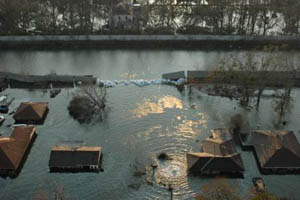
I remember sitting in front of the television with the rest of the world, watching the scene slowly unfold along the gulf coast. Everyone knew that the storm was one of the strongest ever, attaining Cat 5 with winds at one point reaching 175 miles per hour. We all knew that despite the storm weakening slightly just before making landfall, it was nevertheless one bound for the record books. Even when it was still out in the gulf after crossing southern Florida, lazily gaining strength and momentum, it had a certain ominous feel to it, a foreboding aura of invincibility (like that of a Peterbilt 18-wheeler barreling down an interstate overpass at 90 plus), dispensing a chill out ahead of itself — a bone penetrating chill that pierced the oppressive heat and humidity of a typical gulf summer season. This one just felt as if it was truly going to be “the big one” … and it was. It would be a storm to remember. Her name was Katrina.

Once the storm reached major hurricane status, and the mayor of New Orleans began pleading for residents to evacuate and to take this tropical system seriously as it began to paint a bulls-eye on this famous party town, you just knew it was going to be ugly. As I intermittently checked weather reports over the weekend to monitor the progress of what was quickly becoming the perfect pinwheel, I recalled reading an excellent book this same time of the season, some four years ago titled Isaac’s Storm, by Erik Larson. It is a very well written chronicle of the Great Hurricane of 1900, which struck Galveston on September 8. Without the benefit of satellite, radar and computerized tracking technology, the storm approached the Texas barrier island rather unexpectedly, catching the local population off-guard. By the time they had grasped the enormity of the unfolding calamity, it was too late to leave. A train entering the city was swept out to sea by the rapidly rising storm surge, which measured approximately 15 feet, taking 85 men, women and children with it. Others who survived by fleeing the train and taking refuge in a nearby lighthouse with island residents were chased up the internal spiral staircase with each surge of the relentless killer tide lapping at its formidable base. Waves the size of houses swept in from the Gulf, swamping the island habitat. A wave 50 feet long and 10 feet high has a static weight of over 80,000 lbs. Moving at 30 M.P.H., it generates forward momentum of over two million pounds. People’s homes disintegrated, leaving almost half the city in ruins and the remainder heavily damaged. It is estimated that as many as 10,000 people lost their lives to the storm, with at least 2/3 of those deaths occurring on Galveston Island. The remainder were taken by flood waters ravaging inland tributaries, as an octopus’ tentacles reaches for its prey. In Galveston, thousands of bodies were buried at sea, only to have them wash ashore in the following days. With no means of disposal, those and thousands more were then burned in funeral pyres for weeks on end, amid the wreckage of a city destroyed. The smell that settled over the city was overpowering to the survivors, permeating every breath with the scent of a day gone terribly awry. At the time of the storm, the barometric pressure read 28.48 inches of mercury — the lowest ever recorded. Years later, scientists with NOAA readjusted the official reading to be an astonishing 27.49 inches. Wind gusts were thought to be up around 200 miles an hour, generating pressures of 152 pounds per square foot. Sustained winds were estimated at 150 M.P.H., brushing Category 5 status. It continued its improbable march northward, up through the Midwest into Canada. “The storm brought hurricane force winds to Chicago and Buffalo, this even after crossing America’s vast midriff. It killed six loggers trying to make their way across the Eau Claire River and nearly sank a Lake Michigan steamship. It downed so many telegraph lines that communication throughout the Midwest and the northern tier of the nation came to a halt. On Wednesday night, the storm ravaged Prince Edward Island, and then burst into the North Atlantic. Manhattan, half a continent south, received winds of 65 M.P.H. As thousands of men moved into the countryside to replant telegraph poles and string fallen cable, reports began to emerge of shipwrecks in the Atlantic. The storm sank six vessels off Saint-Pierre, six more in Placentia Bay, four at Renews Harbor and drove 42 fishing boats aground in the Strait of Belle Isle between Newfoundland and mainland Canada. The storm raced in a cold and lethal arc across the top of the world until it fell at last into Siberia and disappeared from human observation.” Oddly enough, it changed the course of shaping America. At the time, Galveston was the most thriving city in Texas, an economic powerhouse that overshadowed its inland rival, Houston. It was well on its way to establishing itself as the most successful, influential city in Texas. The Great Storm of 1900 rearranged all of this. After devastating the city, the town lost all its momentum. Houston rose to the occasion, seizing the torch and leading Texas into the 20th Century, emerging as the state’s most populated and most powerful center of commerce, a title it has never relinquished. To this day, this unnamed gale of 1900 still stands as the worst natural disaster in American history. Katrina now bears the potential to match or exceed that. It commands your attention.
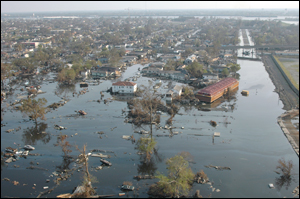 An aerial photo shows the wide-spread devastation in the wake of the levee breaks around New Orleans. The strength of the moving water moved a barge, shown in the right, center area of the photograph. (Courtesy of the U.S. Navy)
An aerial photo shows the wide-spread devastation in the wake of the levee breaks around New Orleans. The strength of the moving water moved a barge, shown in the right, center area of the photograph. (Courtesy of the U.S. Navy)
Fast forward 105 years later from Galveston — another monster, another vulnerable city in its sights. This time the target is New Orleans. It makes landfall Monday, September 5th, turning to the east during its second swipe at land, narrowly missing a direct hit for the first time on a major city in modern day America. Although slightly weakened down to a Category 4 storm, it still packs a powerful wallop, devastating the Mississippi and Louisiana coastlines with high winds and massive tidal surges estimated in some locations at 23 feet. Entire communities cease to exist; neighborhoods are wiped off the map. Thousands upon thousands are feared dead in light of the belief that many could not, or chose not to evacuate. Surprisingly, New Orleans initially seems to have fared well, with only minor wind damage compared to towns to the east. Everyone seems to be breathing easy for the “Big Easy.” Unknown to many, another danger is lurking after the hurricane has made its pass — the levees. With their faulty design, lack of proper maintenance and a storm that drove too much water against them at one time, they were doomed to failure. At five locations, they gave way, spilling millions of gallons of water from Lake Pontchartrain into the city. Block after block, mile after mile become inundated. Houses are flooded up to their roof lines. Most are unoccupied … some are not. I stay glued to the TV as the drama unfolds. I watch the nightly news casts showing people being rescued from their roofs and attics, knowing that the cavalry was on the way to assist a fire department that has to be overwhelmed. The next night, the scenes would repeat themselves and I would think once more “The cavalry is on the way. Things will improve by tomorrow.” I left on a business trip up to D.C. and Philly with the unfolding tragedy on my mind. On the train from Philly back to D.C., I overhear two people behind me venting their outrage and concern regarding the tragedy, yet expressing their relief that they aren’t involved with the response and clean-up. This probably typifies many people’s view … “By God, somebody should do something!! … Just don’t ask me.” A Deputy Chief from the DCFD, John Thumann, picks me up at the train station and kindly gives me a ride to my hotel. We spend a few minutes catching up and talking about the hurricane. It is nice to see him again, a very good man and an excellent structural firefighting chief. At the hotel that night, I see the same scenes playing out all over again, except they continue to worsen as the media penetrates deeper into the city’s carnage. The city sinks into disorder and utter confusion. Rampant looting, police officers walking away from their jobs, rescue helicopters being shot at, a police precinct under siege, people at the Louisiana Superdome, the Ernest N. Morial Convention Center and on highway overpasses marooned, begging for help with little to no food or water available. The sight of bodies floating in the streets and on abandoned cars, as well as frightened, shivering pets trying to fend for themselves continue to assault the senses. A city disintegrating, spiraling into mass chaos. Images come to mind from the Rodney King riots years ago in L.A. where sections of the city are commandeered by thugs and hundreds of buildings are torched (some by the owners themselves for insurance fraud). You wonder how this can happen in this day in age, here within the mightiest and most technologically advanced country on the planet. You wonder how we can dispatch food, water and medicine inside 48 hours to small, remote villages on the other side of the world after the tsunamis, yet people would go five days without help from the government at two primary evacuation sites in the middle of a major metropolitan area here on our home turf. Unbelievable. From the first day, I feel an overwhelming urge to go down there and pitch in somehow, but knowing it is not feasible. I’m no longer an active firefighter, nor associated with a fire service organization. I’m not in that line of work anymore, just a business guy doing disaster planning work.

I’m back home by Thursday, taking in more reports of how bad things are going down there. The topic of recovering what the mayor estimates to be as many as 10,000 bodies is discussed and the first thought that comes to mind for me is how glad I am to not have to be one of the people involved with that task. Recovering badly decomposing corpses while fighting off disease-infested mosquitoes in sweltering heat, wading through polluted, soupy waters contaminated with human waste and remains, along with fuel and toxic chemicals from a variety of sources that would create a highly dangerous environment in which to operate … “I’m happy to pass on that one,” I’m thinking. Then the overheard conversation on the train comes back and the thought immediately begins to haunt me. How can I feel that way, expecting other people to accept an unenviable chore just because I’m no longer on the job and live so far away from the disaster? I remember thinking the same thing after the tsunamis — wanting to help, yet not willing to go. I figure I’ll just throw some money into an envelope, cleanse my soul and move on with the belief that “I’ve done my part, now let someone else get out there and clean-up the mess.” As I do so, a sense of shame settles in. So in response, I make a considerably large donation, somehow believing that if I give more than most other people, I will magically be absolved from my feelings of betrayal and guilt. However, these people need more than just monetary help … they need hands-on help and lots of it. Realizing that there is little chance of going all the way over to the other side of the world and finding just the right place to pitch in, I decide it is best that I stay. Besides, I have a business to run and responsibilities to live up to. So, I join other Americans and helplessly watch the tragedy unfold from afar in the comfort of our living rooms.
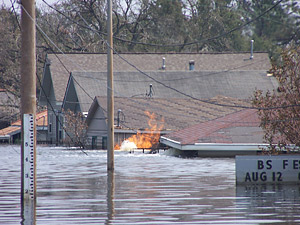
Now, eight months later, the same situation plays out before me and the same feelings arise again. I know I’m not a firefighter anymore, but I also know that I still possess considerable skills that would qualify me to assist on an event of this nature. I have the unique advantage of traveling throughout the U.S. and Canada, constantly meeting with major city fire departments and discussing many, many topics having anything to do with disaster preparedness. I have gained an impressive amount of knowledge from sitting down with hundreds of the top fire chiefs in North America over the past 19 years and getting them to share all they know about large incident responses and also how they prepare and plan for them. Just being at the World Trade Center from 9/11 to 9/21, I was able to soak-up so much knowledge and experience watching the FDNY, NYPD, FEMA and numerous other organizations react to the largest man-made catastrophe in U.S. history. The talent and abilities that were on display those few days I was there was remarkable. The chiefs from the FDNY running different command posts around the site were phenomenal in how they constantly reacted to an ever-changing scene with poise that you would expect to see from generals on the battlefield. My good fortune of seeing all these people in action has taught me a great deal on how major incidents are properly managed. I’ve also always had a knack for being able to see “the big picture” when I’m exposed to large emergencies, sometimes noticing things that other people may not and thinking ahead regarding key issues that might be overlooked. It’s all about pooling resources during these events and getting like minds together to strategize effective solutions to an unfolding, highly dynamic crisis. So here I am once more, less than a year after the tsunamis, watching the coverage from a distance, feeling at once happy I’m not there in New Orleans, yet questioning my motives as to why I am not. A decision is made to at least put forth the effort to see if there is anything I might be able to offer to the cause, alleviating some of the internal struggle gnawing at my insides. The following morning, I call my friends at Firehouse and ask what they are getting in the way of news from the New Orleans Fire Department. Jeff and Harvey give me the run-down and provide a contact for me within the department — District Chief Chris Mickal. I call his cell number and surprisingly, he answers. We have a good talk and he comes across as a very amicable person. Knowing all too well that the media sometimes over-sensationalizes disasters and portrays an inaccurate picture of the current events, I ask him point-blank whether he really needs help. He replies “We can use all the help we can get.”
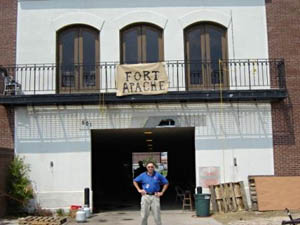
The decision is instantly made. I don’t know what I can or can’t do, but I’m going. I tell him that I’ll be coming down the following day. I have to justify to my employees that I am not making a rash decision and leaving them and the business hanging. I know there is a meeting I needed to put together in Atlanta involving a 60 and 18 story combined office complex that is ready for approval to be pre-planned, just requiring me to attend one last meeting with the manager and the owner rep. Killing two birds with one stone, I arrange the meeting and book the flight to Atlanta, along with a rental SUV. At first, I attempt to get another flight from Atlanta to an airport closer to New Orleans, but booked flights and reserved rental cars dictate that I will have to drive from Atlanta. I decide to be as self-sufficient as possible, carrying with me everything I need to get by for a few days and figuring on buying anything else I would need along the way. I quickly pack and hit the sack early, anxiously awaiting the 3:00 wake-up alarm for my 5:30 flight. With a short connection in Charlotte, I’m in Atlanta by 8:30. I rent a new Chevy Blazer, head downtown and take care of my lone business meeting at SunTrust Plaza with Mike Destro and his associates. Mike is a terrific individual and offers assistance in ensuring my route out of Atlanta is quick and efficient. I’m on the road to New Orleans by noon and accept that the drive will not end until around dark. I make excellent time on I-20 through Georgia, Alabama and on to Jackson, Mississippi, then turn south on I-55 and venture on into Louisiana.
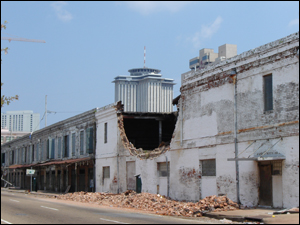 The Category 5 winds caused extensive damage, including collapsed walls and complete building collapses, throughout New Orleans and the entire Gulf Coast Region. (Courtesy of the U.S. Navy)
The Category 5 winds caused extensive damage, including collapsed walls and complete building collapses, throughout New Orleans and the entire Gulf Coast Region. (Courtesy of the U.S. Navy)
During the ride, I wonder if the military personnel that was thought to be assigned to search and recovery had been briefed on the dangers of operating within houses containing drug labs. Almost all low-income areas in most cities contain this threat and the hazardous materials that go along with them can be substantial. I feel an increased sense of urgency to hustle down there and get the word to these people who are probably not considering this danger, that the risks associated with these labs are quite real. They are exposed to enough danger just being soldiers. Strangely enough, other than an occasional swatch of trees felled, there is almost no evidence of a storm having moved through. I pull over at one gas station/general store/truck stop for fuel and run inside to the restroom. As I’m finishing washing my hands next to a nice blue-collar looking man in his late 50s, he asks how I’m doing today and I state “I’m doing pretty good, I suppose. I just wish some of these truckers would stay in the right lane of the interstate if they can’t do the speed limit and let traffic pass them,” in frustration of the day’s drive where trucks would get side by side with each other and completely block the road, not allowing faster moving traffic to pass for miles and miles. You just never see it this bad up north, as most big rigs are quite courteous and predominantly stay to the right when not passing. Down here, other traffic backs up big time, anxiously waiting for these guys or gals to move over. The gentleman senses my frustration as he pauses at the door and says “Well, that might be the case, but just remember when you eat your next meal, where that food came from.” He smiles kindly, having made his point and idles away. Damn! I would have to speak my mind to a trucker, of all people! I quickly call out to him before the door shuts and yell “Amen to that brother!” I’m amazed my empty stomach doesn’t growl in agreement. Good point, I suppose. I guess I need to be more patient and understanding of how folks are in other parts of the country. Stopping only for fuel, “relief stops” and a brief shopping spree at a Wal-Mart next to one of the exits (for water, Gatorade, breakfast bars, an air mattress, bug spray, along with a few other odds and ends), I split Lakes Maurepas and Pontchartrain by early evening, straddling the causeway separating the two masses of water as the sun sets to my right over the beautifully scenic marshland. It reminds me of a scene from Easy Rider, where Peter Fonda and Dennis Hopper chase their dreams on a pair of choppers straight into the “The Big Easy” along a highway hovering over the water much like the one I’m on. It’s probably the same stretch of road. In the movie, they are swooping into the city to experience the world-renowned Mardi Gras as “Born To Be Wild” plays rhythmically in the background. Unfortunately, I’m entering the city after a major hurricane has passed to see if I can maybe offer a hand to response personnel who are up to their ears in bad news. There is no Steppenwolf playing on my radio. Passing small fishing shacks blown apart by high winds and several swamped boats, it becomes more obvious that I’m entering the true hurricane zone. I look off both sides of the roadway and notice the stains on surrounding foliage indicating how high the water had been pushed by the incoming tidal surge. Chief Mickal advises me that the only way into the city is from the west. Bugs the size of the space shuttle continue to assault my windshield in a futile attempt to curb my speed a tad. To no avail, but it almost feels as if I’m pushing the pedal harder to overcome the weight of all the innards now glued to the glass I’m straining to see through. Merging into I-10, traffic begins to slow to a crawl.
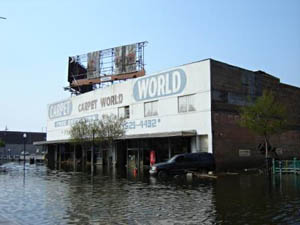
Approaching the first security check point, I state my intentions and a police officer going off-duty offers to guide me into the city and on to the NOFD command post in Algiers. Having never visited New Orleans, I quickly accept his offer. Passing by the downtown area just as it is getting dark, it is clear to me that the city has suffered a serious blow. Moderate wind damage to buildings is evident in the fading light, but I cannot see any signs yet of the massive flood damage depicted on the news. We arrive at the CP via a very circuitous route in about 45 minutes. Algiers is located across the Mississippi River from downtown and sits on higher ground, so flooding there is not an issue. I thank my guide for his assistance and I finally set my sights on the day’s destination after a nine hour drive — the New Orleans Fire Department Command Post — a commandeered nursing home. After parking the truck, I walk down a side street marveling at how much fire equipment is within sight. One guy passes me and says “Welcome to the world’s largest fire station!” and he isn’t joking. I’ve personally never seen so many fire trucks in one place in my life, but I imagine that this must be similar to what the wildland fire command posts must look like out west where they assemble hundreds of fire apparatus at one location to draw from as needed. After making my way to the front entrance, I immediately find Chief Mickal, who has been on-duty for five days straight and has no home to go home to. His house is flooded and all his possessions presumably lost. He seems to be holding up rather well despite it all, but fatigue is obviously setting in. His eyes are bloodshot from a lack of sleep and his calm demeanor belies the burden of stress that resides within him. He is kind, almost to a fault, trying to be cordial amongst all the chaos overtaking his city. I take as little of his time as possible and state that I’ll connect with him in the morning, then head off to my new residence for the next three days — the back of my rented Blazer. Now dark, I open the door to find my air mattress under the dim inside lamp and feel my first (and oddly enough, only) mosquito bite of the trip. Suddenly it occurs to me that in my rush to get here, I forgot to get my shots — Tetanus and Hepatitis A, I think. News reports already run rampant about the threat of disease from the fouled waters and the dead residing within the flooded areas of the city. I glance over at the headrest on the passenger seat and spot my nemesis — a large bloodsucking heathen relaxing after a good feasting. I slowly reach across and then quickly smack him with the palm of my hand. Blood splatters between my fingers and across the seat fabric. I wonder if it’s my blood and if so, what he might have given me as a welcoming gift in return for his evening meal. I quickly decide to climb into the truck and set up my own personal CP in short fashion. I squeeze into the rear cargo area and clear out a spot for my living quarters. I deploy the air mattress and plop down into a compressed heap, basking in the Gulf Coast heat and humidity. Deciding to leave the windows up to avoid the prospect of either slathering myself in insect repellent or being eaten alive during the night, I find my new environs a little uncomfortable, but bearable. I pretend it’s just another camping trip.

Before I know it, the rustling of people awakens me and I rise too, rested but stiff to my first full day in New Orleans. It is still pitch dark, about an hour before sunrise. I’m alert, yet yearning intently for a cup of joe. Forget Starbucks or even 7-11 gourmet stuff, this comes in the form of a filled, small Styrofoam cup on the sidewalk outside the nursing home and its somewhat comparable to the nearby floodwater I suppose — foul but not deadly … yet. It’s amazing what sugar can do to soften a bad flavor. Suddenly, it’s drinkable and downright tasty and I begin to wonder what the day holds for me. I begin to formulate a game plan. After catching up with Chris Mickal and being told where the city’s main command center is, I decide to head into town to get an ID badge and visit city hall, where the department heads are located. Chris kindly provides me a “hall pass” stating that I am assisting with the recovery effort and I’m off as the sun begins to rise. A task force of fire equipment is just leaving the CP for their daily duties throughout the city, so I naturally fall in behind them, turn on my flashers to look more official and follow them down General De Gaulle Drive towards the city center. There must be 20 pieces of apparatus rolling down the roadway, all lit-up nice and pretty. We got ourselves a convoy! Whisking down the deserted street, aside from the occasional patrol car, I notice more of the wind damaged homes and businesses. I can’t begin to imagine what Biloxi and Gulfport must look like, where most of the highest winds were felt. We approach a check-point manned by the National Guard at the toll plaza just before the Crescent City Connection, so I close the gap between us, apply my best serious frown and we’re quickly waived through. Crossing over the bridge as I turn my flashers off, I gain a good view of the downtown skyline and it seems mostly intact, except for one building (the Hyatt) that seems to be missing numerous windows, with drapes flapping in the breeze. It’s pretty trashed. I peel off at the first exit and make my way through the empty city streets towards the business district. Then I begin to notice the troops. Everywhere. About every other street, there’s a platoon marching down the road with M-16s in hand. They have their “game-faces” on. Then come the armored vehicles … Humvees with 50-caliber machine guns, rocket launchers, small cannon, you name it, loaded up with more troops whizzing by in every direction. It is obvious that “the cavalry” is here and they are very much in charge. I quickly track down where to get the official ID badges for the disaster and accomplish that task in a little more than an hour. I then drive up Poydras Street to city hall and take in an up-close view of the Superdome for the first time. It doesn’t appear too badly damaged, other than a considerable amount of the roof covering peeled off, with a single large section dangling over to one side. Cars are abandoned everywhere, with windows and windshields smashed out from looters and marks from the floodwaters several feet above the water, indicating where it was just days ago. Further down, other cars are under water past the hoods. Across the street from the Superdome sits three office towers that are my clients. Other than water damage to the ground level and below, they seem to have fared quite well, with all windows intact.
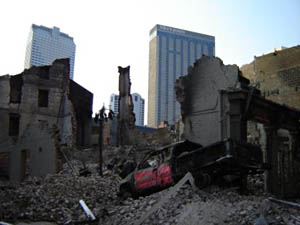
Parking next to the median, I step out of the air-conditioned truck and I’m immediately met with an omnipresent stench, somewhat similar to a mixture of rotting food, sewage water and 7-day old gym socks. Whew! I look up at the buildings directly across the street from city hall and the first thing I see is broken windows, lots of them. Large sections of glass hanging in their frames dangling high up in the air, all the way up to the top floors, some 30 stories above grade. I look around and don’t see any attempts being made to cordon off the area, but there is a crew on foot and in a “BobCat,” cleaning the glass and other debris off the street and sidewalk in front of the buildings. I walk over and motion for them to stop working and to look up. They at first seem annoyed. Yet when I point out the dangers that lurk above them, they seem quite surprised and somewhat concerned, but then quickly go back to work. I mention to the one girl with a broom sweeping the sidewalks that she may want to consider a hard hat. I figure at least her head will stay with her shoulders when they get sliced off by a jagged pane of glass sailing down from 300 feet up. I snap some pictures of the sites around the Superdome and attempt to walk down a side street to the rear for a few shots, but am suddenly challenged by two national guardsmen with automatic rifles raised. They state that I can go no further. I smile and reply “No problem” and gently retrace my steps with a gracious, respectful bow. I then decide to head inside to the nerve center for local, state and federal agencies involved with the event. Somehow, I manage to plug right in and am able to meet briefly with several of the folks who are obviously making some of the more important decisions. John Shelton and Brian Short are coordinating the EOC’s logistics. Captains Mendoza and Pfieffer are handling New Orleans P.D. logistics. We discuss what they have done and what still needs to be done and I explain what I can offer to the cause. They ask me how many pieces of equipment and personnel are at the CP in Algiers and what their needs are, as well as any specialized units assigned there. They also ask if I, or someone else from the CP, can attend morning briefings, so everyone is reading from the same sheet of music. I provide them contact cell phone numbers and suggest they connect. However, I have a feeling that this is already being taken care of.
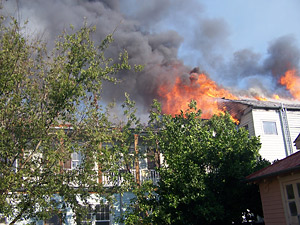
It is such a massive catastrophe; the sheer scope of the disaster is almost overwhelming. There is so much happening and so much that needs to be addressed, you begin to empathize with why things didn’t go too well in the first few days to a large degree. However, you can’t help but wonder how it could have taken so long to get help into the two primary evacuation points. Anyway, these folks are trying with all they’ve got to bring this thing under control. I have no idea what I can do to make a difference, but mention that my people can assist with creating graphics outlining the search grid for the flooded section of the city in an organized, color-coded format. I also bring up the issue of hazardous materials. Everyone realizes by now what is in the water, but what is in the buildings has to be appraised as well. We talk about dry cleaners, hardware and auto parts stores and all the other occupancies that contain hazardous materials that have no doubt been released into the flood waters. Then I bring up the issue of drug labs. This seems to really get John’s attention and he excuses himself for a moment. He returns in about two minutes with one of the officers from the 82nd airborne, who after talking with me about the issue, excuses himself and quickly returns with two of his senior officers — Major Bud O’Hair and Major Todd Berry. I offer what little I know about them — various chemicals, acids and gases used, byproducts of production, exterior tell-tale signs of their presence and methods of protection (including poisonous snakes, guard dogs and IEDs — improvised explosive devices). The threat of the IEDs certainly gets their attention, as many of the troops involved apparently have just returned from the Middle East. The last thing these brave men and women need to be exposed to are much the same things that they dealt with overseas in the war on terror. I’m figuring the chances are somewhat slim they will have to deal with this threat while clearing homes in the low-income areas, yet we all know these labs (whether for meth or other drugs) do exist in every major city. The booby traps are used to protect their investment against both rivals and police, but can easily take the lives of firefighters as well, or in this case, the heroes in our military. I offer to have my office fax them detailed information on the topic, so they can, in turn, properly brief their personnel on what to look for out there in the streets. My offer is accepted. I also suggest using a more refined approach to clearing the homes during the search and rescue/recovery operation using a four-tiered system.

Although this is certainly not my area of expertise, I figure the searches can be accomplished much more efficiently using a four team approach per street, where each team is specialized at accomplishing one specific task. It seems that if one team does nothing more than securing obvious hazards outside and inside each building, the 2nd team can be the forcible entry team where their job is to gain entry into each occupancy (forced or otherwise), the 3rd team becomes the ID unit where their task is to search for victims and if any are found, they only note their location on a log along with any other pertinent data and mark the exterior of the building similar to how USAR teams do it — using spray paint and maybe noting info such as “2A – 1C – attic” to designate two adults, one child located in the attic or “2 FL” for second floor — then the 4th team (either military or private contractor) would actually go in, re-verify the location and type of victims, then remove the bodies. This extra data can prove invaluable in future research into how many people died in their attics, versus other areas of the home and whether they appear to have died from dehydration while occupying an area above the floodwaters, or from drowning in a lower level of the dwelling where water marks are evident above the victim’s heads. Also, if a big haz-mat issue were to arise, they could call in a FD haz-mat unit to assist. This system would allow for a more proficient application of resources and a refinement of an assigned duty in one particular area. Although there would be more troops assigned to each block, the overall effort would be faster and more productive. Each street and block of a given neighborhood checked and cleared would be noted on maps by both field supervisors and the officers at the command post. The commanders really liked the idea and felt that it had a great deal of merit. I’m sure my friends out there on USAR teams are going to get a chuckle out of this, but these troops are carrying out an objective usually performed by firefighters, yet not dissimilar to what they do in a war zone. Here, instead of looking for bad guys, they’re looking for deceased civilians or possible live victims. Upon wrapping up my thoughts verbally, the most senior officer smiles and asks when I had devised this strategy that seems to have peaked their interest and I reply “In my rental car, driving down here from Atlanta yesterday. I had plenty of time to think.” They laugh and we end our discussion with warm handshakes.
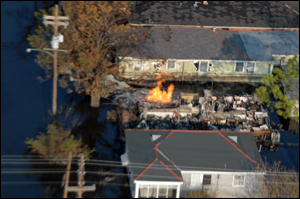 Due to the rapid waters and structures being moved from their foundations, hundreds of gas lines were ruptured or severed, as seen here. It took days, and sometimes week, to shut of the gas utilities to some neighborhoods. (Courtesy of the U.S. Navy)
Due to the rapid waters and structures being moved from their foundations, hundreds of gas lines were ruptured or severed, as seen here. It took days, and sometimes week, to shut of the gas utilities to some neighborhoods. (Courtesy of the U.S. Navy)
Walking astride John and Brian back to their makeshift workplaces, I ask them if they were aware of the glass issue in the buildings across the street and they both look at me a bit puzzled, so I walk them over to a window and point out the danger lurking from above. They state that they were not really noticing or thinking about it that much, due to issues far more important grasping their full attention. I agree that it is not one of the main concerns from the disaster, but explain to them what it was like at the Trade Center, when you would be walking down the street and you would hear a whistling sound gaining in intensity, then a sudden, loud crash just a few feet away from you. Glass shards would explode outward in every direction from where the pane struck the pavement. I would quickly look up to determine where the “incoming” threat originated and finally catch on that there were literally hundreds of shattered windows dangling precariously in their frames 30-50 stories above your head. This was before they started issuing hard hats, clearing glass on those floors and bringing in OSHA to watch for that kind of stuff. I must admit, it was a real attention getter and it happened several times while I was down there — even with no wind to help dislodge them. They would just release and come sailing down the side of the building. It had me looking up quite a bit after the first one. So, after sharing this experience, I suggest to them that maybe they can get a PD unit assigned to cordoning off these few buildings and keep traffic and pedestrians away from the danger. Granted, a lot of the deaths from the storm could not have been prevented, but this situation is clearly controllable. There is no sense in even one person being killed by this threat, when it can easily be addressed and eliminated. Thirty minutes of work with some yellow caution tape and a few barriers and it would be done. They both agree to look into it. Now I’m off to find other people at the nerve center where I might be able to pitch in.
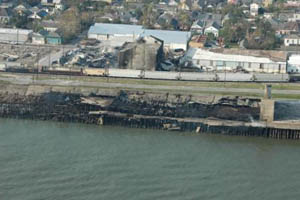
After several hours of mingling with numerous officials and exchanging thoughts and ideas, I decide to finish-up and find somewhere to grab a bite to eat … breakfast bars can only take you so far. I go back outside into the bright sunlight and as I get to my truck, I look across at a news crew taping a segment, while a group of four of what appears to be tourists (with cameras) stroll behind them — all directly beneath the tower with the worst wind damage. Looking up, I can literally see several broken panes flexing in the slight breeze many stories above them. Unaware of the danger, I consider warning them, but realize that as soon as I drive off there will be another group of people doing the same thing and so on, until the area is secure. Hopefully, it will be done before the next front moves through that is expected in a few days, with strong winds. I half-jokingly consider creating a few makeshift signs, saying simply “HEADS UP” and posting it near the entrance to each building, but decide to move on instead. I wander around the downtown briefly enjoying the beautifully unique and colorfully diverse architecture this city offers. Like its people, it seems no two buildings are the same, yet has something of substance to say in an almost spiritual repose. Here I am now on Bourbon Street. Since I’ve never visited New Orleans, it is the first time I have laid eyes on the main attraction spot for tourists. The street is empty … devoid of any sign of human life, as far as you can see. I have to get out and snap a few pictures as I stroll down the street, taking in the invisible character of an atmosphere of good times and good tunes that has fallen silent with a hush that is almost deafening. My footsteps are the only noise being made as the sound of flights above me momentarily falls still. This scene reminded me of another old Hollywood flick from the 70s — The Omega Man, with Charlton Heston. He plays a scientist fighting for survival in a city wiped-out by a biological agent — all the buildings are left standing, but the people are gone … except for, of course, a few zombies hell-bent on killing him. I wonder after taking my next photo how many people have a shot of a completely deserted Bourbon Street. It has to be a one-in-a-million photograph.
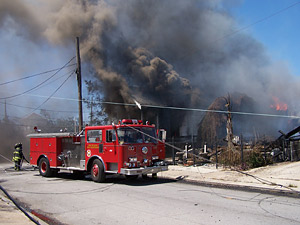
The sounds of military helicopters seem to constantly fill the air the entire time I am here. They are always up there going in one direction or another, ferrying men and supplies to and from various locations, plugging dikes, rescuing people off rooftops or just doing aerial reconnaissance. It is a comforting sound. You know positive things are happening. Every hour of every day that passes means the situation is improving. I move west, further away from the city center and continue taking more pictures. Several buildings had either partially or totally collapsed, with one raining down bricks onto two brand-new vehicles in front, crushing them. Boats in the street are everywhere – one resting in a parking lot, in front of a car with its roof sheared-off down to the hood/trunk line. Clear evidence of rampant looting and arson garners my attention driving down many streets. Lawlessness still rules many parts of the city. Finally, at one point, I’m standing here at an intersection in what appears to be a rather rough area of town, when it suddenly occurs to me that I am completely on my own. Turning in every direction, I no longer see nor hear the now familiar, reassuring sound of military vehicles on patrol. Knowing the city is not yet safe, having been told earlier by a guy at city hall that they were taking fire just the day before – right there in downtown, I knew I was a bit too far out of the “safety zone.” There are still bad guys out and about, armed and with an attitude. Although I don’t hear any sounds at all, it is too eerily quiet and you can almost feel eyes watching you from nearby buildings. A sensation of acute vulnerability quickly sets in. Making haste, I hop into the truck and move on. I feel naked without a weapon for protection.
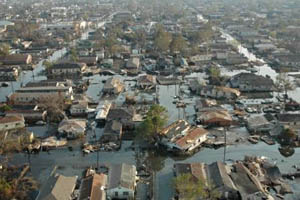
Driving towards the lake, I’m confronted by floodwater too deep to drive through (though I wouldn’t anyway, since I couldn’t stand the stench getting on my “hotel on wheels”). I turn left back towards the city center and come across a police station with a large banner hanging down the front reading “Fort Apache.” THIS is the precinct they had on the news? The one where they were isolated from the outside world, cut-off from help and having to fend for themselves for days on end? I pull over, get out and walk up to a cop standing out front. We start talking and he opens himself up after a few minutes of cop/firefighter chit-chat and he begins to share his tale of how they survived on their own, with their families inside on the second floor, taking fire by local drug addicts and felons. He tells me how they hunkered down on the roof at night and waited for shots to ring out towards their direction; they would then sight in the location of the muzzle flash and return fire until the incoming fire ceased. Then they would stay low in the oppressive, unrelenting Louisiana heat until the next sniper would take a pot shot at them, once again, drawing blistering fire in return. He said it was the most stressful event of his entire life, not knowing if the next round would get lucky and either kill him, one of his comrades, or an innocent family member hiding one floor down. His voice quivered and shook and his eyes began to well-up as he went on to share with me the torturous ordeal of not knowing if you were going to be able to see the next sunrise or not, to see the frightened face of a loved one, one more time during your next break, hoping against hope that they would have enough food, water and ammo to survive until the next day, when surely help would arrive from the outside world to relieve them from their posts, only to have to go through the agony of watching that day pass again into night and having to repeat the process of basic, guttural survival all over again as the local hoodlums gathered you in their sights for another long, nerve-wracking night of standing in the middle of their own personal shooting gallery. He told me he doesn’t know how he lived through it, staring down intently at the piece of concrete separating us. I feel blessed that I can be his sounding board, as anguish, frustration, anger, hopelessness, betrayal, and then simply relief pour out of him in various emotional thoughts poetically conveyed by mere mortal words. I am held spellbound by his story and wish only to hear more, but we are interrupted by a construction crew stopping for directions. I ask his permission to photograph his station, his home, his haven of safety and he agrees. Before leaving, I shake his hand firmly and reassure him how proud we all are in the job he and his fellow officers have done this past week (despite reports of other officers who walked off the job and abandoned their posts when the city needed them most). I felt that it was people like him that exemplified the men and women who represent New Orleans’ Finest, not the others who turned their back on the job, and the city, when it really counted. I drive away humbled by just being in this man’s presence and yet grateful that he felt comfortable enough with me to share his most personal of experiences, the most impressionable period of his entire career. This tall, imposing man was a cop’s cop.
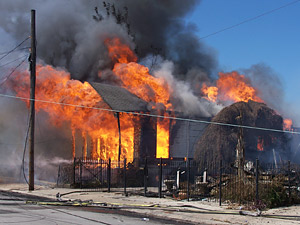
I then drive down to the waterfront area and check-out the mighty Mississippi for the first time, up close and personal. Somehow, I pictured it being a lot bigger…. However, not unlike the Crescent City itself, it does convey a certain aura of majesty, as it winds its way past the business district on the way to its terminus in the Gulf of Mexico. I cannot imagine seeing this now docile river in an angry state of mind. Looking down the street, I spot what looks like a feeding area, with trailers, tents, tables and chairs and smell the faint aroma of cooking food which temporarily overrides the constant smell of the floodwaters. Driving down the block, I see several large trailers with the large logo ICS, which stands for Incident Catering Services I believe. They have prepared a terrific meal with all the fixings, including salad and dessert (which I passed on) for anyone working with the relief effort. There are cops, soldiers, firefighters riding up on the trucks, private contractors and utility workers all zeroing in on what ends-up being the best place in town for a great meal. I come back for two lunches and one more dinner while in town. They really put out a nice spread and even have porta-johns and hand-washing stations set-up. They are wonderfully warm, pleasant people who apparently go to large disasters (mostly wildland fires out west) and are contracted by the government to feed workers involved with the incident. I’m not sure I qualified, but hunger brushed my guilt aside and I dove in with a voracious appetite. It’s funny how food, especially good food, can override feelings of inadequacy. I feel like a free-lancer, but I am trying to help wherever I can at considerable cost to my business. So, copping a free meal or two isn’t too bad, I suppose. It also provides me an opportunity to talk with people from many different occupations who are all striving towards the same, common goal — get the city back on its feet. Everyone has one connecting thread, one of absolute determination. All good Americans possess it and it’s not just a sense of patriotism. I saw and felt the same thing at the site of the World Trade Center attack on 9/11 and the days that followed in New York — an overwhelming desire to right a wrong, be it by terrorists or by nature, and rise to the occasion with a vigor no other people in the world can match. Americans don’t flee disaster sites, they run towards them. It comes from our roots, all the way back to the Revolutionary War and beyond. When we see a wrong that must be righted, then stand aside and let us through, as our sense of duty dictates to our inner-being that we can do nothing other than react and respond, overcome the odds and persevere, come out on top … or die trying.

Ask one of the few survivors of the invasion of Normandy during World War II what resides within them to take on an impossible assignment and come out victorious against odds that are well beyond all reason. Ask a New York firefighter that made the run to the twin towers on Sept. 11 why they would risk certain death by running up into those buildings bound for destruction with virtually no hope to succeed in all their assignments. The answer is, they are Americans and that’s what Americans do. If their job is to fight an unseen enemy at the top of a sheer cliff, rescue people from a burning building teetering on collapse when you know so many surely will perish anyway, or just crawl down into a coal mine day after day for 40 years knowing you will never live to see the golden years of your retirement, it still comes down to getting out there and getting the damn job done — because someone has to do it. Its in our makeup. Just as in New York, I felt tremendously honored to be in the presence of these people and the same feelings of respect and admiration return when I finish eating and drive back across the river to the CP in Algiers, as the blistering hot sun set on another long day.

I am met with a flurry of activity. Firefighters everywhere, wearing t-shirts from outfits I’d never even heard of before, mostly volunteer or suburban small town departments. They have left their jobs and families behind to come a great distance. Their mission is to help their comrades through a challenging and harrowing time. Help was needed and they have responded within their “run area” — one that has no borders. The only major cities that jump out at me are New York and Chicago. New York has their CP in the school building at the front of the complex, Chicago and New Orleans are in and around the nursing home to the rear. Tents all over the place. Campfires burning. Laundry hanging on makeshift clotheslines. Making do. The National Guard has their post set up just outside the school. Everyone has their own thing going, yet they are all chugging along in one mutual direction, pulling together, working towards a common cause. Rescue, relief, recovery. Pure, raw synergy. Parking as close as I can to the nursing home, I notice the portable showers further past the porta-johns as I’m walking towards where the New Orleans group is and decide I should jump at the chance to take my first shower in two days, since they are mostly wide-open with the crews between shifts. The sticky humidity leaves you wanting to shower whenever you can. I go inside the nursing home and catch up with Chris before he heads into another staff meeting. He still looks like he hasn’t slept in a week, but dedication to his duties and his men push him on through the constant fog of fatigue. After a short chat, I grab a quick shower as the last of the sun’s rays fade from view. I forgot to bring a towel, so I use a small hand towel and some paper towels I bought the day prior to dry off, leaving the towel draped across my steering wheel to dry for the next day’s use. I could have bummed a towel, but decide not to.

Afterwards, I bump into the group from Chicago and immediately recognize the chiefs. They are an outstanding group of fire officers and very friendly. Having just seen most of them at their High-Rise Fire Conference in August, where I was invited to speak, it is still good to see them once again. Chiefs Robert Hoff, John Brooks and Peter Van Dorpe were in charge of Chicago’s contingent of the Illinois USAR Task Force. We exchange warm greetings and talk a bit, before noticing how late it is getting. They invite me to stay with them, even offering me an air-conditioned tent and I can’t begin to tell you how good that sounded. However, I reluctantly decline and say I am fine. I just don’t feel that I am “earning my keep” yet and feel undeserving of bunking with people who are truly making a difference out there on the streets every day they are here. My conscience tells me no, so after wandering around for a while conversing with some of the guys, I head back to my Chevy “Marriott” Blazer and curl onto my ol’ trusty air mattress for another restless sleep. After finally falling off, I am awakened just after midnight by two soldiers right outside my window talking aloud about pretty much every topic you can think of. I lay there for a few minutes pondering whether to ask them to move further down the road, then unlike the situation with the trucker, decide against saying anything this time. They are, after all, protecting us against any potential bad guys out there randomly taking pot shots at people, including the good guys. Besides, they obviously don’t know I am here, thinking that everyone at the CP (at least the sane people) are over in the grass area close to the buildings in their respective tents. I am happy the troops are here and they are doing a great job. They eventually go on their way and I nod off here and there until an hour before the dawn of not just another day, but Sunday, September 11, the anniversary of the terrorist attacks.
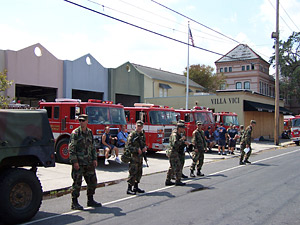
Meandering over to the FDNY CP, I ask who the senior chief is they sent down, figuring I might know him. I’m told it is Chief Michael Weinlein, their Assistant Chief of Operations. Having met him twice before, I know they have sent down one of their “aces.” I watched him command an incident at the (then under construction) Time Warner twin-tower complex in Midtown at Columbus Circle at the base of Central Park on the first anniversary of 9/11. It was a very windy day, with gusts over 50 miles an hour. Construction debris was flying off the roof of the south tower. One of the workers took a break, went across the street, bought a slice of pizza and sat down on the edge of the curb to eat it and either a 2” X 4” or 4” X 4” came off the roof, sailed down to street level at warp speed and nailed the guy square in the head. I was just leaving my hotel with one of the Deputy Commissioners when the call came in. We were only a few blocks away and he decided to take in the call to observe. We were on the scene in a few minutes and from half a block away, you could see the guy was in real bad shape, being tended to by medics and firefighters. We went around the block to avoid being under the building and came around to the just-established command post at the northeast corner of the site, parking a block further away. The OEM (Officer of Emergency Management) acting director was there already, along with several fire chiefs. I recognized Chief Weinlein and went up to say hello. By the time we had walked over to the CP, he had already removed the workers from both roofs, blocked and cleared all streets in a two block radius and secured the surrounding exposure buildings — all in less than 10 minutes into the alarm. Although quite young for a senior chief, he was a rather calm, cool and collected individual. I recall when I was walking around nearby with the wind howling, reminiscing back to that same day a year earlier when I was in New York under less than ideal circumstances, how the streets were just like this day — mostly deserted and very quiet, almost peaceful amid the catastrophe playing out on the southern tip of the island, just a few miles away. I remember my thoughts were interrupted when another piece of debris once again sailed-off the roof, this time striking and shattering a window on the Trump International Hotel building across the street, raining glass down to the street below. I thought I heard a muffled cheer going up from some of the members nearby. So here I am, standing in front of Chief Weinlein once again exactly three years later, four years to the day from the attack on the World Trade Center. The entire CP is humming like a fine-tuned machine. Hundreds of firefighters, all going in seemingly different directions, yet all working towards one shared objective — assist the New Orleans Fire Department get back on its feet. I remember that New Orleans helped out the FDNY by sending a brand-new fire truck to New York after they had lost so many pieces at the Trade Center. It’s obvious the FDNY didn’t forget. I notice a group constructing a stage in the very large front lawn and I ask what it is for. I’m told that they will be having a ceremony commemorating 9/11 … plus, the president will be visiting today. The what? Who? The Big Cheese? All right!!
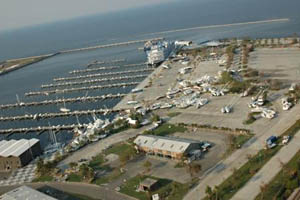
After a quick breakfast, everyone gathers on the lawn for a very poignant Sunday service by local pastors, followed by an excellent, well-delivered speech by Chief Weinlein reminding everyone of the sacrifices made by the brothers four years prior and the era in which we now live. Upon its conclusion, I make my way back over to the nursing home and bump into Chicago’s Chief Van Dorpe and ask him if he needs anything from downtown. He quickly replies yes and states that they need a printer, copier and copies of street maps, as some of the crews have had trouble finding their way around city streets on their own when separated from the NOFD. I feel that I can meet his needs, but as I’m pulling away, Chief Brooks advises me that they’re now OK with everything except the maps. I’m downtown in 15 minutes and have all the copies made within an hour. Spending the remainder of the day helping out wherever I can, I bond a bit with one man I met two days prior — John Shelton. This guy is a mover and a shaker. He just gets things done, overcoming one hurdle after another with dead calm precision under fire. We stay in touch via cell phone off and on throughout my stay. I make it back to Algiers by late afternoon and notice a helo flying low overhead. I glance up and see it is Air Force One. It lands at a hastily prepared LZ on the front lawn. A crew member hops out and runs up to a large crowd of firefighters gathered near the stage and says something, then returns to the idling chopper. The stage is quickly deconstructed and the military guardsmen begin moving the rapidly growing crowd back, establishing a security perimeter. Needless to say, the “main man” must be getting ready to disembark to greet the gang. I wait to see the spectacle, but to my surprise, the aircraft lifts off and disappears from view. Oh well, I guess he doesn’t want to join the party after all. To heck with it. I’m sweating up a storm and need to shower.

As I make my way down the side street leading back towards the New Orleans CP and shower area, I glance over to my right, noticing a commotion near a side door of the school. Then I see him … President George W. Bush, in the flesh. He is making his way through the thin crowd, having snuck in from the rear, for security reasons I suppose. He must not trust firefighters. It’s somewhat funny, because the bulk of the crowd is still up towards the front lawn, unknowing the Big Kahuna has out-flanked them. Curious, I walk-up to get a better look and snap off a few shots (pictures, of course!). He’s dressed in casual work-type clothes and appears slightly shorter in real life. He seems like just a regular guy and very sincere. Sweat beads up on his forehead in the 93 degree heat as he begins to work the crowd. His warm greetings and handshakes are well received by all. I get ahead of him and his posse’ of secret service agents and take a photo of him shaking Chris Mickal’s hand, who’s smile is as broad as the Mississippi itself. The next thing you know, he’s only three feet away from me. So, I extend my hand and he reaches out to grasp it. He offers a good firm grip and gives you this very intense steely look, square in the eyes, as if at that moment in time, you are the most important person in his life and you have his undivided attention. He definitely possesses the “Presidential Presence.” I hear him say over the noise “Thank you for being here” and I reply “Thank you, Mr. President, but I really haven’t done much” — which is true. He is flanked by Mayor Ray Nagin, General Russel Honore (the John Wayne guy) and Coastguard Vice Admiral Thad Allen, who’s now running the show after Mike “Brownie” Brown got the proverbial boot in the keister. I ease back from the crowd to take an up-close picture of him, while being stared down by his bodyguards. They are constantly looking at everyone’s hands, but allowing him free reign to move about where he wishes. He works his way to the chow-line tent and on through the crowd dining inside. Reminding me as to how hungry I am, I leave the festivities and dash back to knock the shower out so I can eat. The President is long gone upon my return, but the meal looks delicious. The place is packed. I sit at the first open chair I see, at a table of black firefighters. At first, they seem a little surprised, but then quickly offer a greeting and accept me into their conversation. Great group of guys. We hit it off well. Upon finishing, it occurs to me that I really can’t offer anything more to the cause and really cannot afford to stay much longer. It costs me thousands of dollars a day to be here and sticking around just can’t be justified. I decide to head back the next day. I go inside the nursing home and work my way down a long corridor to a recreational room with a TV. Sitting down with a New Orleans firefighter, we prop up our feet and strike up a good conversation while watching non-stop news coverage of Katrina’s wrath on the screen by a local news channel, basking in the cool AC. We make small talk of LSU’s chances at a college football national championship and how they managed to miraculously remove the “bed-pan” smell from the nursing home. Before I know it, I’m back in the hot truck with the windows still up, lying on my air mattress pondering the events of these past few days and if I should stay another day or two. Deciding against it, I close my eyes and the day is done.
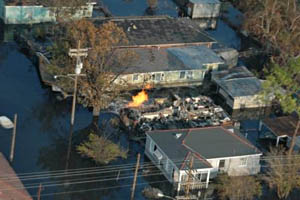
Awakening well before dawn again, I stir with a touch of apprehension, knowing I will be going home today. Making my rounds, I say goodbye to Chris Mickal and the Chicago guys and decide to swing by downtown to say farewell to John Shelton, Brian and the other folks I’ve worked with these past few days. I notice when I get down to city hall that the buildings with the shattered glass have still not been secured. There are glass shards in two places where panes had obviously released and smashed onto the sidewalk below. I ask a police officer inside if they can please look into it before someone gets hurt and he promises me he will. The U.S.S. Iwo Jima (a Navy vessel based in my home town area) is docked at the riverfront, so I figure it would be worth checking with the Navy boys to see if I can get a quick helo flight over the city to photograph and sketch the flooded areas for the city hall guys as a departing gesture. I park near the water and walk down past the Ernest N. Morial Convention Center. So this where all the major league mayhem took place – people beaten, raped and murdered, bodies lying everywhere, children molested and so on (which, as at the Superdome, turned out to be untrue). My eye catches a spent shell casing lying on the ground, evidence of wilder days before. It appears to be from a large-caliber rifle, possibly a 308, definitely not a military M-16. A disgruntled local, I figure, who hopefully missed his intended target. Nearing the entrance to the ship further down, I approach the sentries and state my business. They advise me that the “ship is secure” and ask me to come back in half an hour. It then strikes me that the president must be on board, since there are no hotels that are operating in the city. I walk down about a hundred feet, turn around and sure enough, here comes the president’s caravan rolling off pier side. I wait for it to pass, then walk back, clear the check point and am escorted on board. Walking up a ramp several decks, we then pass through a series of confusing hatches and passageways until we are in the ship’s command and control center. I couldn’t find my way out of here if you put a gun to my head. Multi-colored computer screens abound as I am greeted by the technicians manning the machinery. Surprised to hear we all live in the same city, they graciously give me a brief tour of their hardware and my eye catches one screen that displays the weather for the entire eastern half of the country. Every weather system that may have even the slightest impact on the gulf coast is on a brilliantly lit color display panel. Very high-tech stuff. I ponder for a moment where the remnants of this once mighty storm might be … in Europe probably. My officer escort advises me that they can give me an aerial tour at 1230 hours. Unfortunately, I have to pass, as the flight I have booked is at 1600 … from Jackson, Mississippi. He then mentions that he has taken a series of aerial shots from an earlier flight and shows them to me on another computer screen. They are truly great photos of those first few days, including the levee breaks (and attempted patches by choppers); boats and planes pushed inland near the coast by the rising tidal surge; fires burning above the waterline from natural gas breaks, so he burns them to CD for me and I’m on my way.
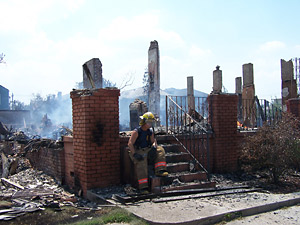
I check my watch and figure that if my flight leaves Jackson in seven hours, there should be enough time to take one last tour of the city and snap a few dozen pictures off. I scour several neighborhoods to capture the worst of what the storm dished out. Driving down one four lane boulevard, I come across large boats lying in the street, several hearses abandoned in the road or up on the median (couldn’t figure that one out — theft I guess, or maybe cruising the local streets for new clientele until their fuel was exhausted), a lazy-boy chair sitting upright in the grassy median, leg-rest extended, with a shoe several feet away, as if the occupant of the chair had made themselves comfortable in the open air, until conditions dictated that they get up and run for their lives, right out of their shoes, in a flight for life. Everything about this storm is odd and out of kilter. In some ways, it reminded me of stark, unforgettable scenes of oddities at the Trade Center — a car with all the windows gone, not even a piece of glass inside the car or out – a chief’s car with a street sign impaled into the sidewall of a steel-belted radial — a ladder truck with the engine compartment that once housed a huge diesel engine crushed down to the height of a milk crate – a tiller ladder, with the tiller, turntable and aerial completely sheared-off, yet the apparatus remains upright — massive girders from the Trade Center impaled in the side of the World Financial Center 20 floors up, across a 6-lane major thoroughfare from where they came — a hood peeled up and almost completely off a car, but TOWARDS the collapse zone! These same bizarre scenes lie before me once again. Looking to my right at one intersection and seeing every tree on the entire block (large and small) blown over into the roadway, completely blocking it, then turning my head to the left and seeing no signs of damage whatsoever all the way into the distance. I take one shot of a funeral home sign (probably shy a few hearses) with the sign reading “Prearranged Funeral Plans — Funeral Services/Cremation/Limousines” … I think I know where their limos are … and the high water mark from the flood quite evident, up at about the 4’ level. Driving back towards the interstate, I think about the murder and mayhem that took place on these very streets only days earlier and then I just happen to look up at a billboard right in front of me, with the phrase in bold, black letters — “Thou Shalt Not Kill.” Mmmm.

Leaving the downtown area, I stop for a moment to study the map and figure that I can hop on I-10 and head straight west out of the city. Knowing the east-bound section is destroyed, I feel comfortable going the opposite direction towards Baton Rouge, then up to Jackson for my plane ride home. Rather than bothering having to cross the street, I just drive up the exit ramp onto a deserted freeway and accelerate smoothly up to about 70, stealing quick glances to each side of the road at the remarkable devastation that envelops the city. Collapsed buildings, crushed cars, boats high and dry in the middle of streets, housing developments as far as I can see completely under water, every street, driveway, intersection, parking lot — flooded. Then I pass a huge graveyard, with more mausoleums than I can possibly count. However, contrary to media reports, there are no bodies or skeletons floating out of their graves that I can see. The interstate carves a line right through the middle of it. It is the rather sizeable Greenwood and Metarie Cemeteries. A large statue, of what appears to be a Civil War monument, sits off to my left. I recall another scene from Easy Rider where Peter and Dennis and two women do some “acid” and wander around this same graveyard in a psychedelic stupor after experiencing Mardi Gras, as well as a scene from a James Bond movie filmed at this location — Live and Let Die. If nothing else, this place has gobs of character. Continuing to glance here and there to each side as my speed rises, occasionally dodging debris in the road — coolers, folding chairs, umbrellas, clothes, the usual stuff (no doubt this highway served as some people’s home for the first few days after the storm), then I glide over the next overpass, almost floating, and voilà! My eyes drift back to the road in front of me … something rapidly gaining my full attention ahead … water — where its not supposed to be … everywhere! I immediately snap out of my doldrums and slap the pedal to the medal (the brake pedal, thankfully) and bring the truck to a screeching halt. My eyes remain transfixed on the sight in front of me — the road dips down into an underpass, disappearing from view beneath a calm, flat sheath of water rising all the way up to within five feet of the overpass sign. At first, I’m shocked by what I see (but I shouldn’t have been, since all the surrounding area is under water), then I’m suddenly left with a sinking feeling in my gut. This was my way out of here. I have a flight from Jackson, now leaving in five hours and my only way out is apparently going all the way back from where I started out this morning in Algiers, then working my way over to the Huey P. Long Memorial Bridge, then over the river again to Jefferson to get to Rte. 61 and on to I-10. No time to waste now, gotta really pick-up the pace.

I whip the truck around and head back the other direction, hauling butt east bound on the west bound side of the interstate. I finally slow down as I approach some opposing traffic — a cop car, then a few pieces of military equipment, loaded with soldiers and firepower. We lazily wave or nod to each other in passing, as if this kind of thing is completely normal and acceptable on any given day — a major city, mostly deserted, under military control, yet no real law enforcement outside of the unspoken rule “Don’t be carrying a gun and not have a uniform on!” Then as I near the Mississippi, I get off at the next on-ramp, then over to the other side of the road and back on the correct side of the freeway. Boy, these are the kind of memories that will be with you for life…. Once I’m finally out of the city and on my way early into the afternoon, I begin to ponder why I chose to come here. What did I accomplish that could be deemed worthwhile? Oddly enough, as the long hours on the road pass while the hot summer sun slowly eases its way over to the far horizon, I churn these thoughts in my head and still can come up with no real answer. It leaves me feeling quite hollow inside, since doubt and disenchantment now replaces my sense of purpose, which is what drove me here to begin with. It doesn’t come to me until weeks later, when out of the blue, I receive an email from this magazine’s editor, Harvey Eisner. He asks me if I would be interested in writing a “short story” (now that’s funny!) about the hurricane. I had already sent him all the photos I had taken (about 240) for any use he might have for them, so he knows I had been there. I replied yes, although it meant putting another article I was working on for him on hold. Late that evening, I tune in CNN to check the latest coverage from New Orleans and to my dismay, am surprised to see a camera panning down one of the towers across from city hall with dozens of broken windows, all the way down to street level, where it zooms in on a makeshift sign that appears to be either plywood or cardboard with yellow tape stretched out in both directions surrounding the immediate area. The sign reads “Danger — Falling Glass Above!” I break into a smile.
The next day, I call a good friend just to say hello, Roger Sakowich — a Battalion Chief with the FDNY. He runs out of lower Manhattan as Battalion 1. He is one of the finest, most sincere individuals you will ever meet and he takes his job quite seriously. Although he is too humble to admit it, Roger is easily one of the top 10 best high-rise firefighting chiefs in the world. After a few rings, Roger answers his cell and where is he? New Orleans. He says he came down as part of a second contingent from New York to assist their brothers in the south. We begin to chat and I hear a voice in the back ground, a familiar voice of someone I just recently met — Chris Mickal. I laugh and ask Roger to tell him hello, but instead, he laughs himself and hands the phone to Chris. We speak for a couple seconds, catching up. God, it’s a small world! That’s when it finally occurred to me why I was destined to go to New Orleans. To meet men like Chris Mickal and take Harvey’s email as a challenge – to write about what it was like, to share my experiences with firefighters and other people who read the best magazine of its kind in the world. There are so many folks who want to know more about what these disasters present to the people who live through them … and respond to them. It is then an honor for me to pass on the true depth of character, the pride and enthusiasm, the courage and integrity that is on vivid display at every one of these events. While the media covered one or two local citizens rescuing a few people from their flooded homes, the NOFD was out there beyond the reach of the cameras, rescuing scores and scores of people, exhaustingly depositing them on highway overpasses and going back for more, while the world sat transfixed in front of their televisions, wondering where the first responders were.
From the smallest to the largest fire departments in North America; the doctors, nurses and medics; the heroic men and women of our military and especially during this event — our Coast Guard and Navy, who made so many improbable, risk-filled rescues; police officers; game wardens and veterinary specialists who went in to rescue so many abandoned or forgotten pets; construction and utility workers and countless volunteers who stayed before, during and after the storm or came to New Orleans to help after the hurricane’s wrath had taken its toll … there they were, out on the streets, helping people whose lives were altered or destroyed, get themselves and their city back on its feet and functioning again. These are our “first responders.” People who would be willing to risk what they have in order to help people they’ve never met who now possess nothing, to rebuild or restore property they never owned, to assist a city they’ve never been to before.
Today, two months after the storm, I picked-up the morning paper and saw a picture of a group of citizens from Minnesota, New Jersey and other states far removed from this disaster, sifting through debris along the gulf coast where homes once stood, where lives once flourished, helping to piece together the tattered remnants of communities torn asunder by nature’s awesome, destructive fury. These people were on their vacation. Their vacation! They had chosen to give up their hard-earned time off, fly down to the gulf at their expense and spend their vacation offering a helping hand to their fellow Americans. This photograph and its caption moved me. This, I thought, says it all. This is why I am writing my story.
Katrina did not decimate us, she brought us together. She provided the means to display the iron-fisted will and intestinal fortitude that makes our people so unique and so awe-inspiringly special. There is a pulse which flows through our society that bounds intensely strong and steady — too powerful to be altered by catastrophes. We bounced back from Andrew, Oklahoma City, September 11 and now Katrina and Rita with unyielding resolve and a burning, unquenchable passion to never allow ourselves to be knocked down for longer than a brief moment in time, but a slight pause in history. The brave-spirited people who preceded us and taught us these valuable lessons in human compassion can hopefully now see the fruits of their labor in who we are and what we stand for. It is our responsibility to ensure these same lessons are passed on to our children, so when a future crisis might occur, man-made or by nature, they will be there, ready and willing to be the next generation of “first responders.” Without question, “The Road to Katrina” lies within us all.
Credit to author Erik Larson — for excerpts and quotations from Isaac’s Storm and Chief Chris Mickal of the New Orleans Fire Department. Thanks to Chief Chris Mickal, as well, for some of the photos. Thank you to the Canadian USAR Teams who unselfishly assisted their brothers and neighbors in need of their skills. Thanks and praise to all the members of the NOFD for hanging in there through the most trying of times in unbearable conditions … and getting the job done!